The following was originally published by the Ash Center for Democratic Governance and Innovation at Harvard University’s John F. Kennedy School of Government as part of its Occasional Papers Series.
City officials engaged in efforts to improve their local landscapes for innovation in public problem solving should consider three questions:
1)What strategies are we pursuing and how do we know if they are actually working?
2)How do we communicate the value of our efforts to the public and other stakeholders—creating demand for innovation?
3)How can we institutionalize our work to ensure that future administrations will sustain these efforts?
The goal of the assessment tool is to help cities develop a sophisticated approach to supporting and promoting innovation by assessing their
current efforts through the lens of the strategies in the framework for an innovative jurisdiction (discussed in the miniseries), adapting the
framework to their local contexts and communities and capturing metrics in a manner that responds to the three questions above.
The assessment tool reflects a framework comprising three main strategies, each of which has three components.
•For each component, the assessment tool guides cities to identify a set of desired objectives to guide their innovation efforts.
•For each objective, the assessment tool presents a set of key questions to help actors evaluate whether, or to what degree, they are
meeting stated objectives.
•For each question, in turn, the assessment tool lists sample indicators that a city could employ to formulate an answer.
The components, objectives, questions and indicators that a city chooses to utilize should take into consideration the local context including
mayoral priorities, political feasibility and operational capacity including availability of data and other resources.

The assessment tool is designed from the perspective of those whose portfolios include responsibility for driving innovation, which could
include a mayor’s office, city agency or innovation team. It aims to help cities identify their priorities and assess their progress in
developing a more innovative jurisdiction. Because most cities are deploying some type of performance measurement system, they might
incorporate this assessment tool into their existing measurement systems. The tool could also serve as a stand-alone system. No matter the
approach, pulling data from as many sources as available across the city is important because the tool addresses a broad array of issues.
Some cities might choose to utilize the assessment tool as a rating or grading mechanism. Publishing results from the assessment tool
internally or publicly might prove useful to building legitimacy and support for local innovation offices and teams.
Occasional Papers Series from the Ash Center for Democratic Governance and Innovation
John F. Kennedy School of Government, Harvard University
Assessment Tool p1
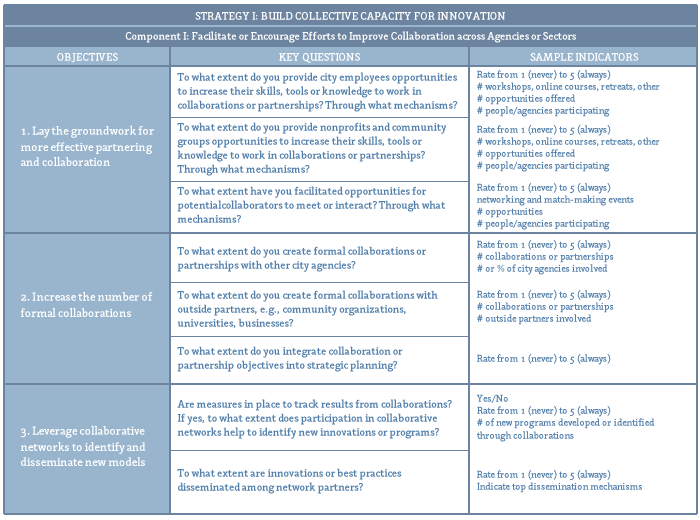
Assessment Tool p2
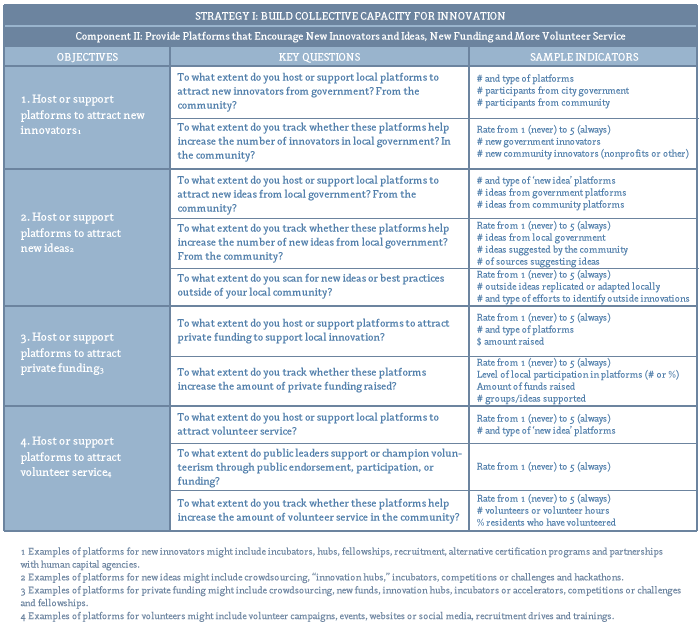
Assessment Tool p3
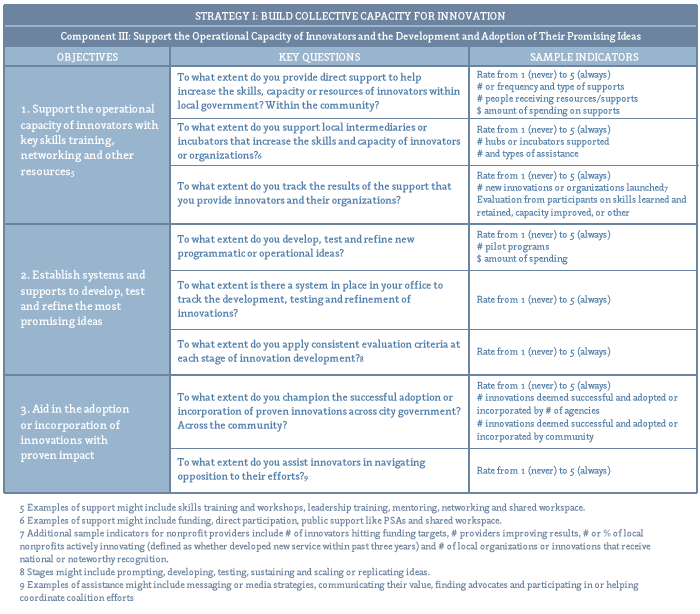
Assessment Tool p4
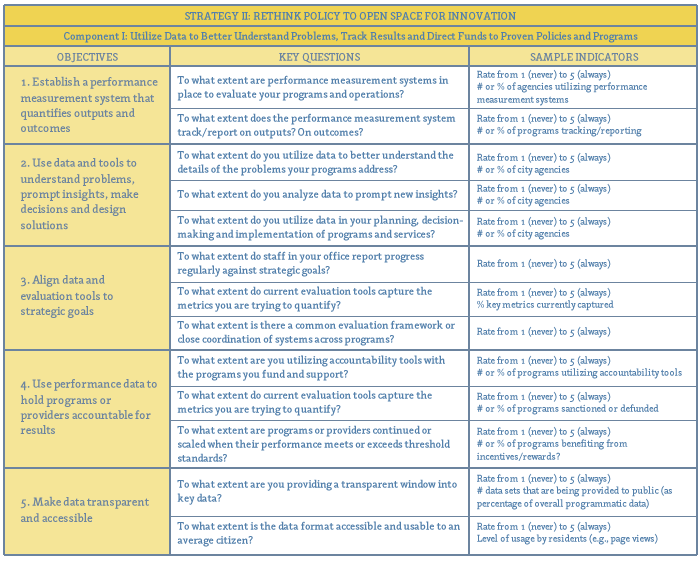
Assessment Tool p5
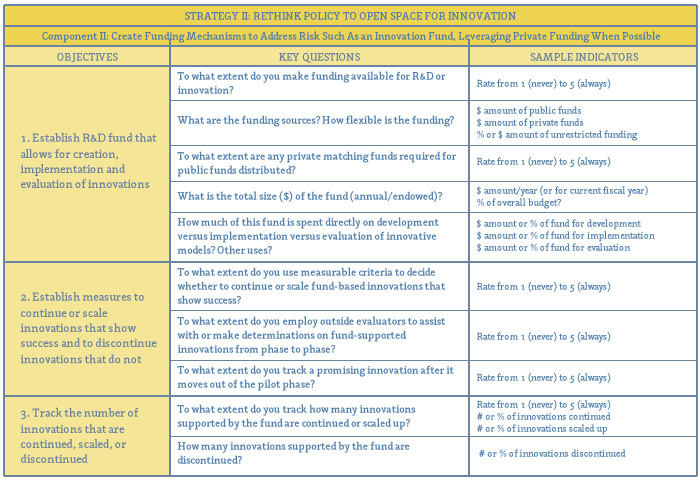
Assessment Tool p6
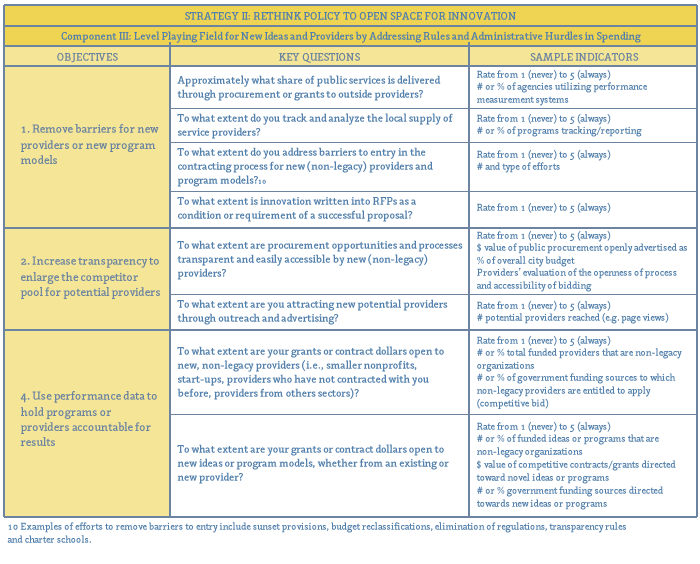
Assessment Tool p7
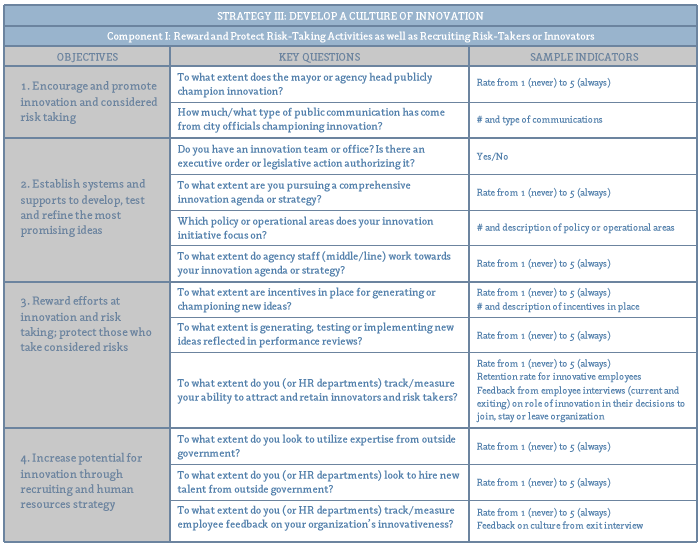
Assessment Tool p8
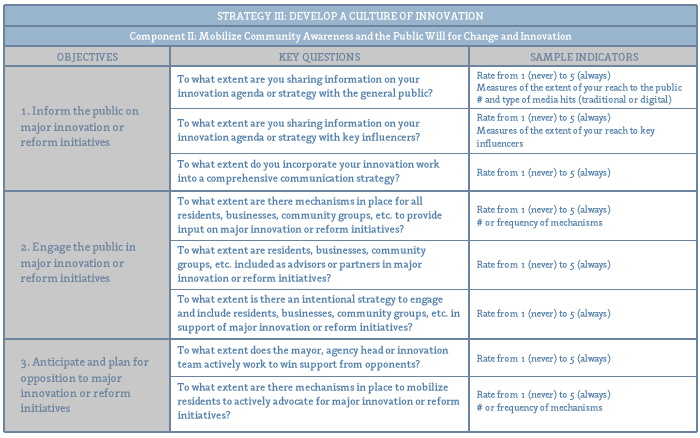
Assessment Tool p9
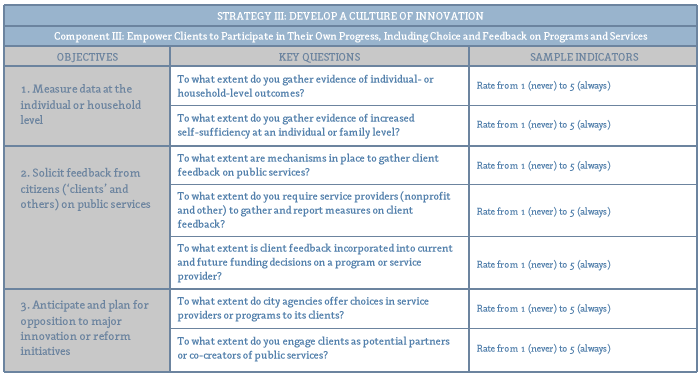
Selected Resources on Innovation Landscape Assessment
Australian Government Department of Innovation, Industry, Science and Research. “Public Sector Innovation Toolkit.”
http://innovation.govspace.gov.au/
Australian National Audit Office. “Innovation in the Public Sector: Enabling Better Performance, Driving New Directions (Better Practice Guide).” December 2009.
http://www.anao.gov.au/bpg-innovation/index.html
Bloch, Carter, Lydia Lassen Jørgensen, Maria Theresa Norn, and Torben Bundgaard Vad. “Public Sector Innovation Index: A diagnostic tool for measuring innovative performance and capability in public sector organizations.” CFA-DAMVAD, October 2009.
http://nestainnovation.ning.com/forum/topics/measuring-innovation-within
The Center for American Progress, U.S. Chamber of Commerce, and Frederick M. Hess. “Leaders and Laggards: A State-by-State Report Card
on Educational Innovation.” November 2009.
http://www.americanprogress.org/issues/education/report/2009/11/09/6915/leaders-and-laggards/
Special Report: The Government Dashboard.” February 2012.
http://www.govtech.com/pcio/special_reports/special-report-dashboards.html
Corporation for National and Community Service and National Conference on Citizenship. “Volunteering and Civic Life in America 2012.”
http://www.volunteeringinamerica.gov/. [City-level data on volunteerism and other civic engagement.]
Cortright, Joe. “City Vitals 2.0: Benchmarking City Performance.” CEOs for Cities, 2012.
http://www.ceosforcities.org/
http://www.cfa.au.dk/
Deloitte. “Driving Innovation in the Public Sector: Developing an Innovation Index.” October 2009.
http://nestainnovation.ning.com/forum/topics/measuring-innovation-within
http://www.cfa.au.dk/
Gillett, Stacey. Presentation for Webinar “
Building a Culture of Innovation in Government: An Example from New York City Public Schools,” August 15, 2011. Recording and related resources available at
http://www.innovations.harvard.edu
The GreeningUSA.
12 Traits of Sustainable Communities. May 2010.
http://www.greeningusa.org/
Hartman, Kat. “D3 + UIX : INSIGHT - The Skills Required for Innovation.” Urban Innovation Exchange. April 12, 2013.
http://www.uixdetroit.com/features/uixd3oneyear.aspx
Hughes, Alastair, Matt Farren-Hanford, and Craig Baker. “Public Sector Innovation Index: Exploratory Project.” Ernst & Young. October 2009.
http://nestainnovation.ning.com/forum/topics/measuring-innovation-within
Hughes, Alastair, Kyla Moore, and Nimesh Kataria.
“Innovation in Public Sector Organisations: A pilot survey for measuring innovationacross the public sector.” Nesta. March 2011.
http://www.nesta.org.uk/publications
The Innovation Unit.
“An Innovation Index for the Public Sector: Final Draft Report.” Nesta. October 2009.
http://nestainnovation.ning.com/forum/topics/measuring-innovation-within
John S. and James L. Knight Foundation and Gallup. “Soul of the Community.”
http:/www.soulofthecommunity.org/
Jong In Yoon. “Government Innovation Index (GII): Concept, Development & Application.”
Headquarters for Government Innovation, Ministry of Government Administration and Home Affairs, Republic of Korea. June 2006.
http://unpan1.un.org/intradoc/groups/public/documents/un/unpan023428.pdf
The Massachusetts Technology Collaborative and John Adams Innovation Institute. “Index of the Massachusetts Innovation Economy.” 2010.
http://www.masstech.org/research-and-analysis/innovation-index
Metis Associates. “Evidence of Organizational Change: Qualitative Assessment of the NYC CEO’s Impact on NYC Agencies and Provider Organizations.” October 2009.
http://www.nyc.gov/html/ceo/html/home/home.shtml
Mulgan, Geoff, Julie Simon, and Louise Pulford. “Study on Social Innovation for the Bureau of European Policy Advisors.” The Young Foundation. March 2011.
http://youngfoundation.org/publications/study-on-social-innovation-for-the-bureau-of-european-policy-advisors/
Nesta. “Annual Innovation Report 2010.” January 2011.
http://www.nesta.org.uk/areas_of_work/economic_growth/the_innovation_index/assets/features/annual_innovation_report
OECD and EuroStat. “The Oslo Manual: Guidelines for Collecting and Interpreting Innovation Data.” 2005.
http://www.oecd.org/innovation/inno/oslomanualguidelinesforcollectingandinterpretinginnovationdata3rdedition.htm
Partnership for Public Service. “Best Places to Work in the Federal Government Analysis: Most Innovative Agencies.” May 2013.
http://bestplacestowork.org/BPTW/index.php
Preskill, Hallie and Tanya Beer. “Evaluating Social Innovation.” FSG Center for Evaluation Innovation. 2012.
http://www.fsg.org/tabid/191/ArticleId/708/Default.aspx?srpush=true
Pro Inno Europe. “Paper No. 15: European Innovation Scoreboard 2009: Comparative Analysis of Innovation Performance. 2009.
http://www.slideshare.net/victori98pt/european-innovation-scoreboard-eis-2009
USA.gov. “Performance Dashboards.”
http://www.usa.gov/Contact/Engagement/Dashboards.shtml


